Tignanello Wine: A Comprehensive Guide
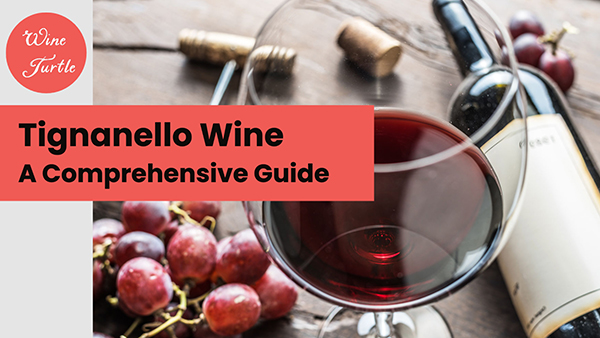
Take a deep dive into the wonderful Tignanello wine from Tuscany in our big guide.
It's a wine that commands the respect of critics vintage after vintage but what makes it so special and why did it get off to a rocky start in Italy?
An Introduction to Tignanello Wine
Tignanello wine is a remarkable blend of Sangiovese, Cabernet Sauvignon, and Cabernet Franc grapes that has been captivating wine enthusiasts for decades.
The wine's history dates back to the 1970s when the Antinori Winery, one of the oldest and most prestigious wineries in Italy, decided to create a new wine that would challenge the traditional winemaking practices of the Chianti region.
The wine was named Tignanello after the vineyard where the grapes were grown, located in the heart of the Chianti Classico region in Tuscany, Italy.
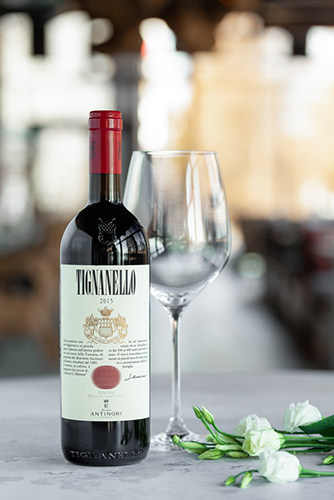
The first vintage of Antinori Tignanello was produced in 1971, and it quickly gained recognition for its unique blend of grapes and exceptional quality.
Tignanello wine played a significant role in the Super Tuscan movement, which emerged in the 1970s and challenged the strict regulations of the Italian wine industry.
The Super Tuscan wines were produced outside the traditional wine regions and were made from non-traditional grape varieties, such as Cabernet Sauvignon and Merlot. These wines were often aged in oak barrels, which gave them a distinct flavor profile that was different from the traditional Italian wines.
Tignanello wine was one of the first Super Tuscan wines, and it quickly gained popularity among wine enthusiasts and critics alike. The wine's unique blend of grapes, combined with its aging process in oak barrels, gave it a complex flavor profile that was both elegant and powerful.
Today, Tignanello wine is considered one of the most iconic wines in the world, and it continues to receive critical acclaim and high ratings from wine critics. The wine's popularity has also led to an increase in demand and price, and it can be found in wine shops and restaurants around the world.
In terms of characteristics, Tignanello wine is known for its deep ruby color and complex aroma, which includes notes of red fruits, spices, and vanilla. On the palate, the wine is full-bodied and well-structured, with a long and persistent finish.
The winemaking process for Tignanello wine is meticulous and involves a careful selection of grapes, fermentation in stainless steel tanks, and aging in oak barrels for up to 14 months. The wine is then aged in the bottle for an additional 12 months before release.
Tignanello wine pairs well with a variety of dishes, including roasted meats, game, and aged cheeses. It is also a great wine to enjoy on its own, as a special treat or to celebrate a special occasion.

Tignanello Wine: A Brief History
The Antinori family has been producing wine for over 600 years and is considered one of the most prestigious winemaking families in Italy. It’s with them that the story of Tignanello wine begins.
The Antinori family's role in the development of Tignanello wine began in the 1960s when they decided to experiment with new grape varieties and winemaking techniques.
At the time, the Italian wine industry was heavily regulated, and winemakers were required to follow strict guidelines that limited their creativity and innovation.
The Antinori family saw an opportunity to challenge the status quo and create a new style of wine that would showcase the best of Italian winemaking, without the rigid rules.
In 1971, the first vintage of Tignanello was released, and it immediately made waves in the wine industry. The wine was a blend of Sangiovese, Cabernet Sauvignon, and Cabernet Franc grapes, which was a departure from the traditional Chianti blend of Sangiovese and mainly other indigenous Italian grape varieties.
The use of international grape varieties was controversial at the time, but the Antinori family believed that it would produce a wine of exceptional quality and complexity.
The impact of Tignanello on the Italian wine industry was significant. The wine was a part of the Super Tuscan movement, which was a group of winemakers who challenged the traditional winemaking practices of the time.
The movement was characterized by the use of non-indigenous grape varieties, such as Cabernet Sauvignon and Merlot, and the use of French oak barrels for aging.
The Super Tuscan wines were often more expensive than traditional Italian wines, but they were also of exceptional quality and were highly sought after by wine enthusiasts around the world.
Tignanello was at the forefront of the Super Tuscan movement, and its success paved the way for other winemakers to experiment with new grape varieties and winemaking techniques. The wine's popularity also helped to elevate the status of Italian wine in the global wine market.
Today, Antinori Tignanello is considered one of the most iconic wines in the world, and it continues to be a symbol of innovation and quality in the Italian wine industry.
Tignanello wines command huge fees and it’s a wine that few people have the privilege of tasting. This is due to the limited supply with the wine coming from just one vineyard location and also due to the wine's exceptional aging potential.
The high tannic structure means it is a wine that does well with a few years in the cellar, making it a profitable wine for collectors to hold.
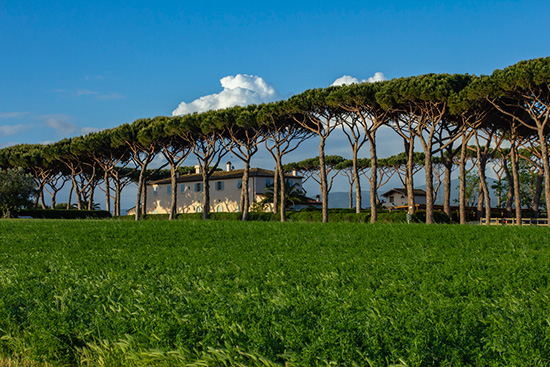
Antinori Winery Headquarters in Tuscany
The Tignanello Vineyard
The Tignanello vineyard is located in the heart of Tuscany, Italy, on the Antinori estate in the Chianti Classico region.
The estate covers around 319 hectares (788 acres) in its entirety with around 130 (321 acres) dedicated to grapevines.
The location provides an ideal climate for grape growing, with the days being hot throughout the growing season with cool evenings. This allows the grapes to ripen slowly and develop complex flavors. The winters are also usually mild which the vines enjoy.
The soil composition of the Tignanello vineyard is unique, with a mixture of marl, marl limestone, and calcareous rocky soil.
This combination of soil types creates a well-draining environment that allows the vines to develop deep root systems and absorb the necessary nutrients for healthy growth.
The soil's high limestone content also contributes to the wine's minerality and acidity, which are essential characteristics of Tignanello wine.
The vineyard is primarily planted with Sangiovese grapes, which make up 80% of the vineyard's total area. The remaining 20% is planted with Cabernet Sauvignon and Cabernet Franc grapes, which are used to create the wine's unique blend.
The Sangiovese grapes provide the wine's structure and acidity, while the Cabernet Sauvignon and Cabernet Franc grapes contribute to its complexity and depth of flavor.
Vineyard management practices at Tignanello are focused on sustainability and organic farming methods. The vineyard is certified organic, and the grapes are grown using natural fertilizers and pest control methods.
Cover crops are also used to promote soil health and prevent erosion. The vineyard's irrigation system is designed to conserve water, with drip irrigation used to deliver water directly to the vines' roots.
In addition to sustainable farming practices, the Tignanello vineyard also employs innovative techniques to improve grape quality.
For example, the vineyard uses a technique called "green harvesting," where unripe grapes are removed from the vines to allow the remaining grapes to fully ripen and develop their full flavor potential.
The vineyard also uses a technique called "cluster thinning," where excess grape clusters are removed to improve the quality of the remaining grapes.
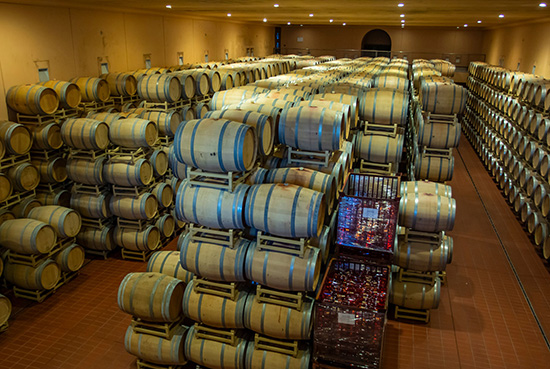
Wine aging in Antorini Winery
Tasting Notes and Characteristics of Tignanello Wine
Tignanello wine is a complex and elegant blend of Sangiovese, Cabernet Sauvignon, and Cabernet Franc grapes, resulting in a wine that is both rich and balanced. The wine's appearance is a deep ruby red color, with hints of purple and garnet.
On the nose, Tignanello offers a bouquet of ripe cherries, blackberries, and plums, with notes of vanilla, tobacco, and spice.
The aroma is intense and inviting, with a subtle hint of oak.
The flavor profile of Tignanello is equally impressive, with a full-bodied and velvety texture that is both smooth and rich.
The wine's tannins are well-structured, providing a firm backbone that supports the wine's complex flavors. The fruit flavors are dominant, with notes of cherry, blackberry, and plum, accompanied by hints of vanilla, tobacco, and spice.
The wine's finish is long and persistent, with a pleasant aftertaste that lingers on the palate.
Experts and critics have consistently praised Tignanello for its complexity and balance.
The 2016 vintage in particular had wine critics swooning. Wine Enthusiast actually awarded it 99 which is pretty incredible! James Suckling, Robert Parker’s Wine Advocate and Wine Spectator all scored it an impressive 97.
But, to be honest, every vintage scores something close to this.
Tignanello Food Pairings
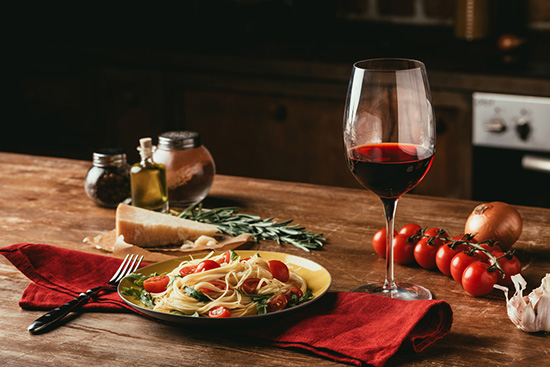
When it comes to food pairings, Tignanello has a robust character and complex profile making it an excellent match for a variety of dishes.
Traditional Tuscan dishes such as pasta with meat sauce, roasted meats, and aged cheeses are all excellent choices. A classic Tuscan dish that pairs well with Tignanello wine is bistecca alla fiorentina, a thick-cut steak seasoned with salt, pepper, and olive oil and grilled over an open flame.
Here are some of my absolute favorite Tignanello wine food pairings:
The Winemaking Process
Tignanello wine is renowned for its unique blend of Sangiovese, Cabernet Sauvignon, and Cabernet Franc grapes, expressed by exceptional terroir.
But the winemaking process is equally important in creating the wine's complex flavor profile.
In this section, we will explore the various stages of the winemaking process, from harvesting to aging.
Harvesting and Sorting of Grapes
The first step in the winemaking process is the harvesting and sorting of grapes. At Antinori Winery, only the best grapes are handpicked to ensure the highest quality of wine.
The grapes are then sorted using both hand sorting and sorting machines to remove any damaged or imperfect grapes.
Fermentation and Maceration
After sorting, the grapes are destemmed and crushed to release the juice. The juice is then transferred to temperature-controlled stainless steel tanks for fermentation.
During fermentation, yeast is added to the juice to convert the sugar into alcohol. The temperature of the tanks is carefully monitored to ensure that the fermentation process proceeds at the optimal temperature for the particular grape variety.
Maceration is the process of allowing the grape skins to remain in contact with the juice during fermentation. This process extracts color, flavor, and tannins from the grape skins, which contribute to the wine's complexity and structure.
Aging Process and Use of Oak Barrels
After fermentation and maceration, the wine is transferred to oak barrels for aging. The type of oak used and the length of aging are critical factors in the final flavor profile of the wine.
Antinori Winery uses a combination of French and Hungarian oak barrels for aging Tignanello wine. French oak imparts flavors of vanilla, spice, and toast, while Hungarian oak adds flavors of coconut and dill.
The length of aging also varies depending on the vintage and the desired style of the wine.
Tignanello wine is typically aged for 12-14 months in oak barrels, followed by an additional 12 months of aging in the bottle before release.
During this time, the wine undergoes a natural clarification and stabilization process, which further enhances its flavor and aroma.
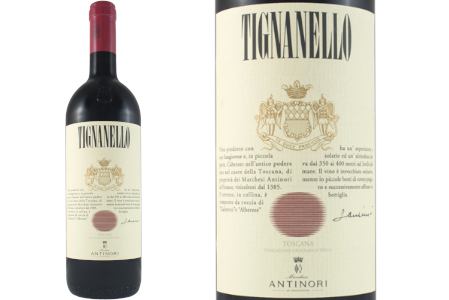
Tignanello Wine in the Current Market
Tignanello wine is a highly sought-after wine by enthusiasts around the world. It is available for purchase at many wine shops, online retailers, and directly from the Antinori Winery.
The price of Tignanello wine varies depending on the vintage and the retailer, but it typically falls within the range of $100 - $300 per bottle.
Consumer demand for Tignanello wine has remained consistently high over the years, with many wine critics and experts praising its quality and complexity.
The fact that it ages so well makes it a sound investment too. A bottle of Antorini Tignanello can improve (under the right conditions) for something like 20 years in the bottle.
When compared to other Super Tuscan wines, Antinori Tignanello stands out for its distinctive blend and aging process. It is often compared to other Super Tuscan wines such as Sassicaia and Ornellaia, which also use international grape varieties in their blends.
However, Tignanello is unique in that it uses a higher percentage of Sangiovese grapes, which gives it a distinct Tuscan character.
Although Tignanello is on the higher end of the price spectrum when compared to other Super Tuscan wines, its quality and reputation justify its price point, making it a worthwhile investment for serious wine collectors.
Tignanello Wine and the Future
The Antinori family has been producing wine for over six centuries, and they have always been at the forefront of innovation in the wine industry.
As they look to the future of Tignanello wine, they are considering potential changes to the blend or winemaking process to continue to improve the quality of the wine.
One potential change that the Antinori family is considering is the use of different grape varieties in the blend. While Sangiovese, Cabernet Sauvignon, and Cabernet Franc have been the mainstay of Tignanello wine, the winemakers at Antinori are constantly testing new grape varieties to see how they might complement the existing blend.
Another potential change is the use of different aging techniques. While Tignanello wine is currently aged in oak barrels, the Antinori family is exploring the use of different types of wood, such as chestnut or acacia, to see how they might affect the flavor profile of the wine.
Despite the potential for change, the Antinori family is committed to maintaining the high quality of Tignanello wine. They believe that the unique blend of Sangiovese, Cabernet Sauvignon, and Cabernet Franc is what sets Tignanello wine apart, and they will always prioritize the quality of the grapes and the winemaking process.
However, there are potential challenges and opportunities that the Antinori family must consider as they look to the future of Tignanello wine.
One of the biggest challenges is climate change, which is affecting vineyards around the world. Extreme heat is having a huge effect on the growth and quality of wine grapes.
The Antinori family is taking steps to mitigate the impact of climate change, such as planting vines at higher elevations and using sustainable farming practices.
Interested in Trying Tignanello wine? It's available on wine.com

It’s $129.00 at Walmart and it’s $119.00 at Target. Both stores sold out online. Google it some bottles are $500.00 and up.
I can’t drink red wine because it’s high in sulfa. So I have to pass on “The TIG”.